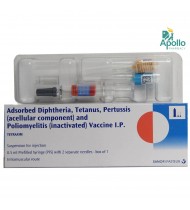Diphtheria, Tetanus, Pertussis, Poliomyelitis Vaccine
Composition
One dose (0.5 mL) contains:
- Diphtheria toxoid ≥30 IU
- Tetanus toxoid ≥40 IU
- Pertussis toxoid: 25 micrograms
- Filamentous haemagglutinin: 25 micrograms
- type 1 (Mahoney strain): 40 DU
- type 2 (MEF-1 strain): 8 DU
- type 3 (Saukett strain): 32 DU
Indications
This vaccine is indicated for the prevention of diphtheria, tetanus, pertussis and poliomyelitis:
- for primary vaccination in infants from the age of 2 months, for booster vaccination, one year after primary vaccination during the second year of life,
- for booster vaccination between 5 and 13 years of age, according to official recommendations.
Dosage & Administration
This vaccine must be administered according to the official recommendations in effect. Primary vaccination: 3 injections given at an interval of one month, i.e. according to the official schedule, at the age of 2, 3, 4 months.
Booster vaccination: 1 injection one year after primary vaccination, i.e. usually, between 16 and 18 months. Booster vaccination between 5 and 13 years of age: 1 injection. For primary vaccination and for the first booster dose, this vaccine may be administered by reconstituting the Haemophilus influenzae type b conjugate vaccine (Act-HIB) or administered at the same time as this vaccine, but at two separate injection sites.
Administer via the intramuscular route. Administration should preferably be performed in the antero-lateral side of the thigh (middle third) in infants and in the deltoid area in children
Booster vaccination: 1 injection one year after primary vaccination, i.e. usually, between 16 and 18 months. Booster vaccination between 5 and 13 years of age: 1 injection. For primary vaccination and for the first booster dose, this vaccine may be administered by reconstituting the Haemophilus influenzae type b conjugate vaccine (Act-HIB) or administered at the same time as this vaccine, but at two separate injection sites.
Administer via the intramuscular route. Administration should preferably be performed in the antero-lateral side of the thigh (middle third) in infants and in the deltoid area in children
Interaction
This vaccine can be administered simultaneously with the M-M-RVAXPRO vaccine or with the HBVAXPRO vaccine, but in two separate sites This vaccine can be associated or combined with the Haemophilus influenzae type b conjugate vaccine (Act-HIB).
Contraindications
Hypersensitivity:
- to any of the active substances of this vaccine,
- to any of the excipients listed in section 6.1,
- to glutaraldehyde, neomycin, streptomycin, or polymyxin B (used during the manufacturing process and which may be present as traces)
- to a pertussis vaccine (acellular or whole cell).
Side Effects
The safety profile is described below according to the clinical data generated in France, South Korea, Chile and Thailand. In clinical studies in children who received TETRAXIM as a primary series, stand alone or combined with the Act- HIB vaccine, the most frequently reported reactions are local injection-site reactions, abnormal crying, loss of appetite and irritability. These signs and symptoms usually occur within 48 hours following the vaccination and may continue for 48-72 hours. They resolve spontaneously without requiring specific treatment. The frequency of injection-site reactions tends to increase at booster vaccination compared with the frequency observed for primary series. The safety profile of TETRAXIM does not differ significantly according to age groups. However certain reactions (myalgia, malaise, headache) are specific to children aged 2 years or more.
Precautions & Warnings
The immunogenicity of this vaccine may be reduced by immunosuppressive treatment or immunodeficiency. It is then recommended to wait until the end of the treatment or disease before vaccinating. Nevertheless, vaccination of subjects with chronic immunodeficiency such as HIV infection is recommended even if the immune response may be limited. If Guillain-Barre syndrome or brachial neuritis has occurred in subjects following receipt of prior vaccine containing tetanus toxoid, the decision to give any vaccine containing tetanus toxoid should be based on careful consideration of the potential benefits and possible risks of vaccination. Vaccination is usually justified for infants whose primary immunization schedules are incomplete (i.e. fewer than three doses administered).
Do not inject via the intravascular route: make sure the needle does not penetrate a blood vessel. Do not inject via the intradermal route. As with all injectable vaccines, This vaccine must be administered with caution to subjects with thrombocytopenia or a bleeding disorder since bleeding may occur following an intramuscular administration to these subjects.
Do not inject via the intravascular route: make sure the needle does not penetrate a blood vessel. Do not inject via the intradermal route. As with all injectable vaccines, This vaccine must be administered with caution to subjects with thrombocytopenia or a bleeding disorder since bleeding may occur following an intramuscular administration to these subjects.
Therapeutic Class
Vaccines, Anti-sera & Immunoglobulin
Storage Conditions
Keep out of the reach and sight of children. Store at +2°C to +8°C. Transportation should also be at +2°C to +8 °C. Do not freeze. Discard solution if frozen. Protect from light.
Tetraxim SC Injection 0.5 ml prefilled syringe
CompositionOne dose (0.5 mL) contains:Diphtheria toxoid ≥30 IUTetanus toxoid ≥40 IUBordetella pertus..
2,490.00Tk.
Showing 1 to 1 of 1 (1 Pages)

